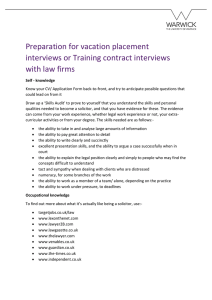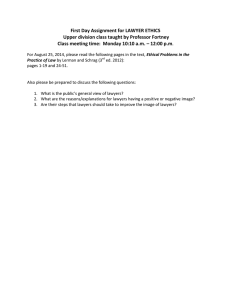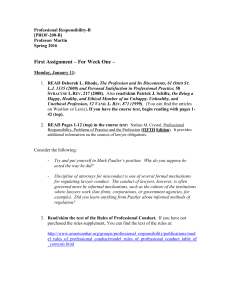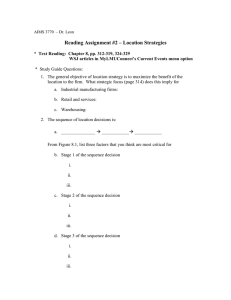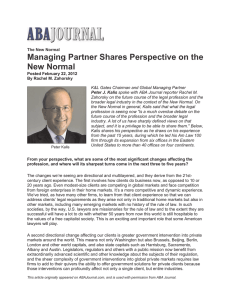"Form, Function, and Fiduciary Law"
advertisement
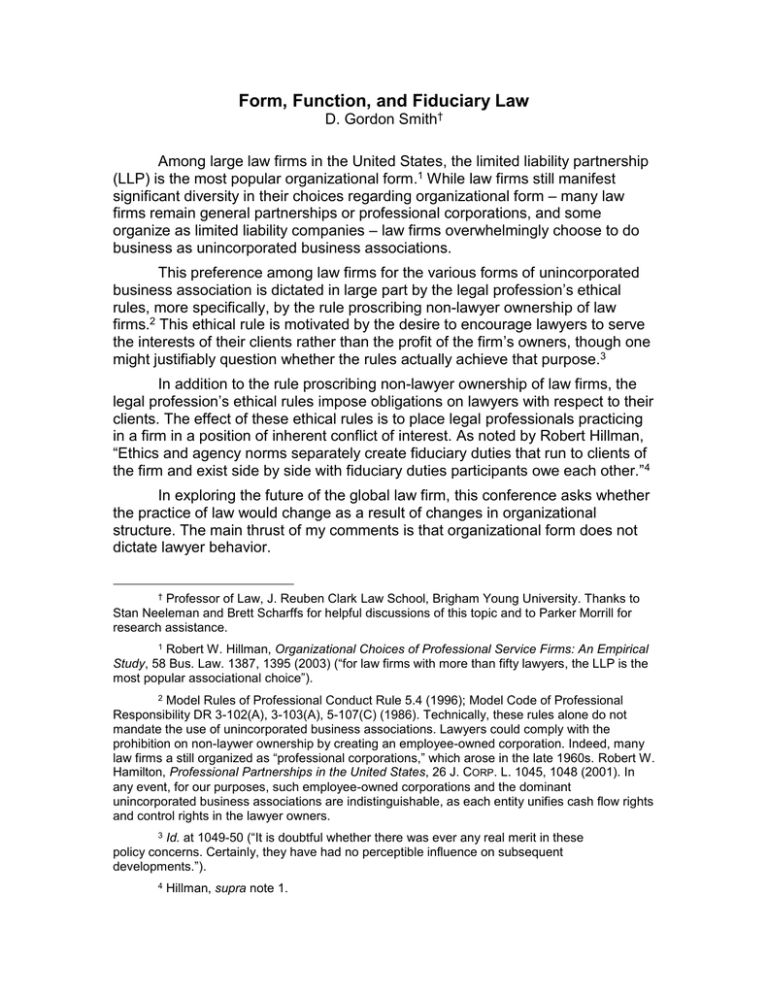
Form, Function, and Fiduciary Law D. Gordon Smith† Among large law firms in the United States, the limited liability partnership (LLP) is the most popular organizational form.1 While law firms still manifest significant diversity in their choices regarding organizational form – many law firms remain general partnerships or professional corporations, and some organize as limited liability companies – law firms overwhelmingly choose to do business as unincorporated business associations. This preference among law firms for the various forms of unincorporated business association is dictated in large part by the legal profession’s ethical rules, more specifically, by the rule proscribing non-lawyer ownership of law firms.2 This ethical rule is motivated by the desire to encourage lawyers to serve the interests of their clients rather than the profit of the firm’s owners, though one might justifiably question whether the rules actually achieve that purpose.3 In addition to the rule proscribing non-lawyer ownership of law firms, the legal profession’s ethical rules impose obligations on lawyers with respect to their clients. The effect of these ethical rules is to place legal professionals practicing in a firm in a position of inherent conflict of interest. As noted by Robert Hillman, “Ethics and agency norms separately create fiduciary duties that run to clients of the firm and exist side by side with fiduciary duties participants owe each other.” 4 In exploring the future of the global law firm, this conference asks whether the practice of law would change as a result of changes in organizational structure. The main thrust of my comments is that organizational form does not dictate lawyer behavior. † Professor of Law, J. Reuben Clark Law School, Brigham Young University. Thanks to Stan Neeleman and Brett Scharffs for helpful discussions of this topic and to Parker Morrill for research assistance. 1 Robert W. Hillman, Organizational Choices of Professional Service Firms: An Empirical Study, 58 Bus. Law. 1387, 1395 (2003) (“for law firms with more than fifty lawyers, the LLP is the most popular associational choice”). 2 Model Rules of Professional Conduct Rule 5.4 (1996); Model Code of Professional Responsibility DR 3-102(A), 3-103(A), 5-107(C) (1986). Technically, these rules alone do not mandate the use of unincorporated business associations. Lawyers could comply with the prohibition on non-laywer ownership by creating an employee-owned corporation. Indeed, many law firms a still organized as “professional corporations,” which arose in the late 1960s. Robert W. Hamilton, Professional Partnerships in the United States, 26 J. CORP. L. 1045, 1048 (2001). In any event, for our purposes, such employee-owned corporations and the dominant unincorporated business associations are indistinguishable, as each entity unifies cash flow rights and control rights in the lawyer owners. 3 Id. at 1049-50 (“It is doubtful whether there was ever any real merit in these policy concerns. Certainly, they have had no perceptible influence on subsequent developments.”). 4 Hillman, supra note 1. Organizational theorists assume that form follows function, but the premise of the legal profession’s ethical rules is quite the opposite. The legal profession’s ethical rules encourage a particular law firm structure (form) with an eye toward protection of the public and the consumers of legal services (function). What attributes of the preferred form (for simplicity, we assume that form is a partnership) are thought to encourage socially responsible lawyering? The most common answer to that question is that lawyer ownership is said to ensure “that lawyers exercise their professional judgment free from interference by non-professionals who may not have client interests at heart or who may not be guided by the standards of the legal profession.”5 As Professor Ribstein recognizes, this is a dubious rationale for the prohibition against nonlawyer ownership. It assumes that lawyer owners have more to lose from actions contrary to a client’s interests than non-lawyer owners, and it assumes that lawyers-qua-owners are more attentive to the potential for misconduct than lawyers-qua-employees. A less obvious answer to the question posed above is that the partnership form reduces agency costs between lawyers and clients. Jonathan Levin and Steven Tadelis assert that “the defining feature of a partnership [is] redistribution of profits among partners.”6 According to Levin and Tadelis, “Profit sharing leads individuals to be particularly selective as to whom they take on as partners. This feature of partnerships assures clients of quality service.” 7 As with the first answer, this answer is unpersuasive. Levin and Tadelis focus on the quality of professional services, but the relevant ethical rules are aimed at lawyer opportunism, not lawyering competence. Commentators on the legal profession often cite the role of fiduciary duties in specifying lawyer behavior. In my view, fiduciary duty is best viewed as a loose constraint on lawyer behavior. The primary function of fiduciary law is to deter conflict of interest transactions, not to inspire diligence. Lawyer-owners and lawyer-employees both would have fiduciary obligations to the business association within which they practice, and on a practical level, those obligations are indistinguishable. Moreover, both would have fiduciary obligations to clients. While most malpractice claims arise in tort (based on the lawyer’s alleged failure to provide reasonable representation), not fiduciary duty, a lawyer may be liable for breach of fiduciary duty in any circumstance where the attorney is acting as an agent for the client. Nevertheless, the imposition of such duties is unlikely to depend on whether the lawyer is acting as a partner or as an employee. If, as suggested by the foregoing comments, organizational form does not specify lawyer behavior, why do lawyers behave as they do? One of the pillars of 5 Larry E. Ribstein, Ethical Rules, Agency Costs, And Law Firm Structure, 84 VA. L. REV. 1707, 1721 (1998). 6 Jonathan Levin & Steven Tadelis, Profit Sharing and the Role of Professional PartnershipsI, 120 Q. J. Econ. 131, 131 (2005). 7 Id. -2- social science research is the notion that almost all behavior is overspecified, and this is almost certainly true of lawyer behavior. Without going into great detail, I would suggest three likely sources of lawyer behavior: market forces, professional identity, and professional norms. With respect to the core issue of client service, there is no reason to suspect that law firms with non-lawyer ownership would be less vigilant than lawyer-owned firms. In their thorough debunking of the arguments in favor of the prohibition of non-lawyer ownership, Edward Adams and John Matheson conclude, “nonlawyer-controlled law firms, which could take the form of private entities with nonlawyer ownership or publicly traded corporations, would be in the business of providing legal services and would succeed only by providing sound legal judgment to consumers .”8 Moreover, the lawyer-employees of such a firm would still be subject to existing ethical obligations in rendering their professional services.9 Social identity theory was developed to explore issues of intergroup discrimination.10 Though the literature often speaks of “in groups” and “out groups,” the focus of social identity theory is predominantly on individuals.11 One extension of social identity theory that seem particularly relevant to the current issue is the concept of professional identity. Individuals who identify as “lawyers” will exhibit behaviors that are consistent with that identity. Closely related to professional identity is the notion of professional norms. In this section we will discuss the origins of professional norms, which seem to have only a tenuous connection with the organizational forms in which lawyers practice, and argue that these norms contribute substantially to the desired outcome of socially responsible lawyering. The modest goal of this essay is to argue that organizational form does not dictate lawyer behavior. But this is not to suggest that the aspirations of the legal profession’s ethical rules will necessarily be frustrated. Rather, I suggest merely that lawyer behavior is determined by forces other than organizational form. 8 Edward S. Adams & John H. Matheson, Law Firms on the Big Board? A Proposal for Non-Lawyer Investment in Law Firms, 86 CAL. L. REV. 1, 16 (1998). 9 Id. at 18. 10 See Henri Tajfel & John Turner, “The Social Identity Theory of Inter-group Behavior,” in S. W ORCHEL & W. G. AUSTIN, EDS., PSYCHOLOGY OF INTERGROUP RELATIONS (1986). 11 See, e.g., ROY F. BAUMEISTER, IDENTITY: CULTURAL CHANGE AND THE STRUGGLE FOR SELF (1986) (equating identity with “self-definition”). -3-
